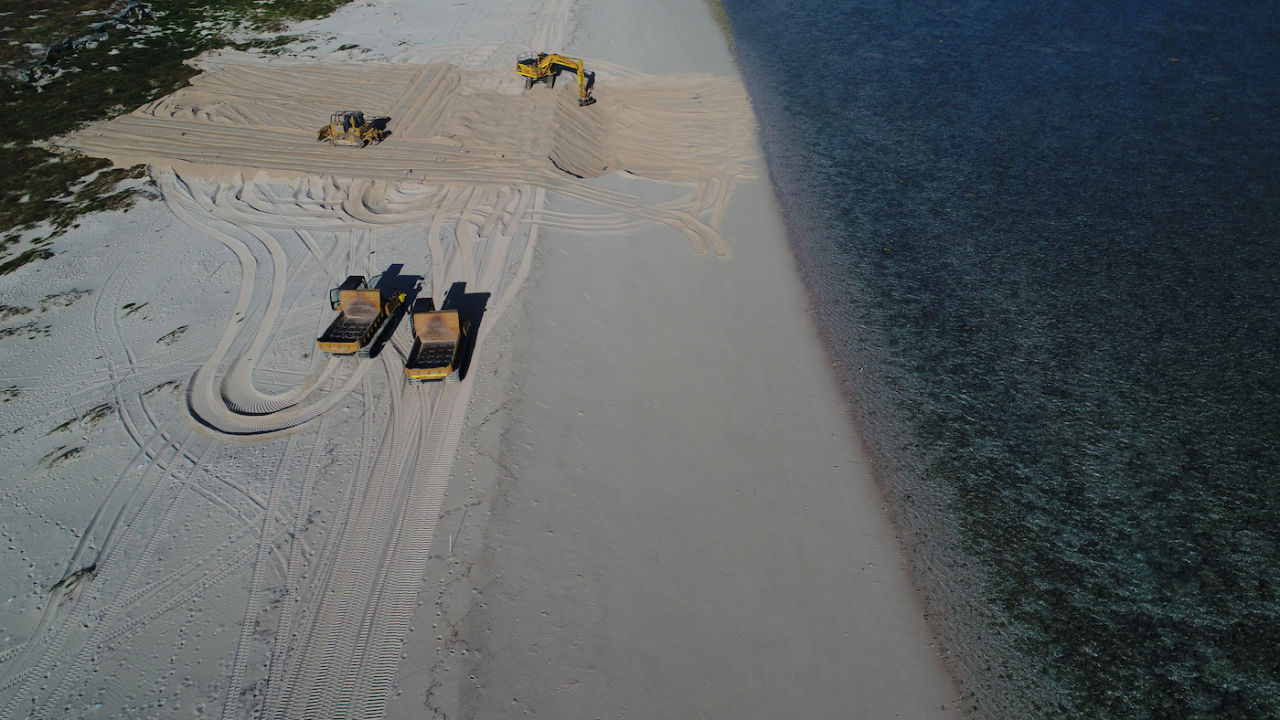Media Release ·
Mission accomplished to re-shape Raine Island

Hundreds of turtles now have a brighter future following the completion of the latest rescue mission at Raine Island.
Member for Barron River Craig Crawford said rangers from Queensland Parks and Wildlife Service (QPWS) worked with Traditional Owners, researchers from James Cook University and local contractors to re-shape elements of the island’s landscape as part of ‘Operation Sand Dune’.
“During Operation Sand Dune, more than 15,000 cubic metres of sand – the equivalent of six Olympic-sized swimming pools – were moved to re-shape Raine Island’s beaches to raise the nesting area above the high tides that are flooding and destroying precious turtle eggs,” Mr Crawford said.
“An additional 300 metres of turtle exclusion fencing was also installed to prevent potentially thousands of adult turtle deaths from falling off cliffs on to their backs. This has increased the total length of life-saving fencing on the island to 1450 metres.
“It is estimated that fencing alone has saved over 500 breeding turtles, which is a great result for the world’s largest nesting site of green sea turtles.
“Completing Operation Sand Dune was the next big step in the Raine Island Recovery Project and followed a successful re-profiling trial that took place in 2014.
“About 1.8 hectares of the beach area has now been re-shaped, increasing the viable nesting area for turtles on the island by about 20 per cent.”
The Raine Island Recovery Project is a five-year, $7.95 million partnership between BHP, the Queensland Government, the Great Barrier Reef Marine Park Authority, Wuthathi Nation and Kemer Kemer Meriam Nation (Ugar, Mer, Erub) Traditional Owners and the Great Barrier Reef Foundation.
It aims to protect and restore the island’s critical habitat to ensure the future of key marine species, including green turtles and seabirds.
Mr Crawford said the project is a pioneering public-private partnership and the first large scale adaptive management project on the Reef.
“These partnerships include James Cook University and the Traditional Owners and are integral to the Raine Island Recovery Project,” Mr Crawford said.
The Wuthathi and Kemer Kemer Meriam Nation Traditional Owners of Raine Island are key partners in the Raine Island Recovery Project, working collaboratively on the priorities, direction and works on the island.
Not only is Raine Island the largest nesting site for green sea turtles in the world, but it is a significant cultural and story place for Aboriginal and Torres Strait Islander people.
The Kemer Kemer Meriam Nation are from the eastern most Torres Strait Islands of Ugar, Mer and Erub, while Wuthathi Nation are from Cape York.
Mr Crawford said both groups played a crucial role in the project.
“During the recent trip, the Wuthathi and Kemer Kemer Meriam Nation rangers led the installation of the turtle exclusion fencing,” he said.
“Traditional owners are involved in every field trip to Raine Island and play a critical role in delivering all aspects including help with turtle monitoring, seabird counts, fencing and other works.”
Operation Sand Dune also gave James Cook University researchers the opportunity to study how the island’s shape is changing, to inform the future strategies and priorities needed to best preserve the vital reef island ecosystem.
Associate Professor Scott Smithers said the JCU’s research would “significantly improve the existing understanding of how the Island’s geomorphology – essentially its shape – affects turtle nesting and hatching success there.”
“In this case it will help to further inform and refine efforts to give turtles a helping hand,” Dr Smithers said.
“The results will have wider applications for ecosystems and communities who depend on reef islands and cays throughout the tropics.”
Mr Crawford said Operation Sand Dune took 22 days to complete and was completed on 8 September 2017.
“This was a massive undertaking in a very remote location, as Raine Island sits more than 600km north of Cairns and 120km off the coast of Queensland,” he said.
“Saving this critical Great Barrier Reef habitat for turtles and seabirds is a priority recognised in the Reef 2050 Long-Term Sustainability Plan and the Raine Island Recovery Project is a wonderful example of what can be achieved when government, business, traditional owners and not-for-profits organisations work together.
“I congratulate all those involved in completing this mammoth task.”




